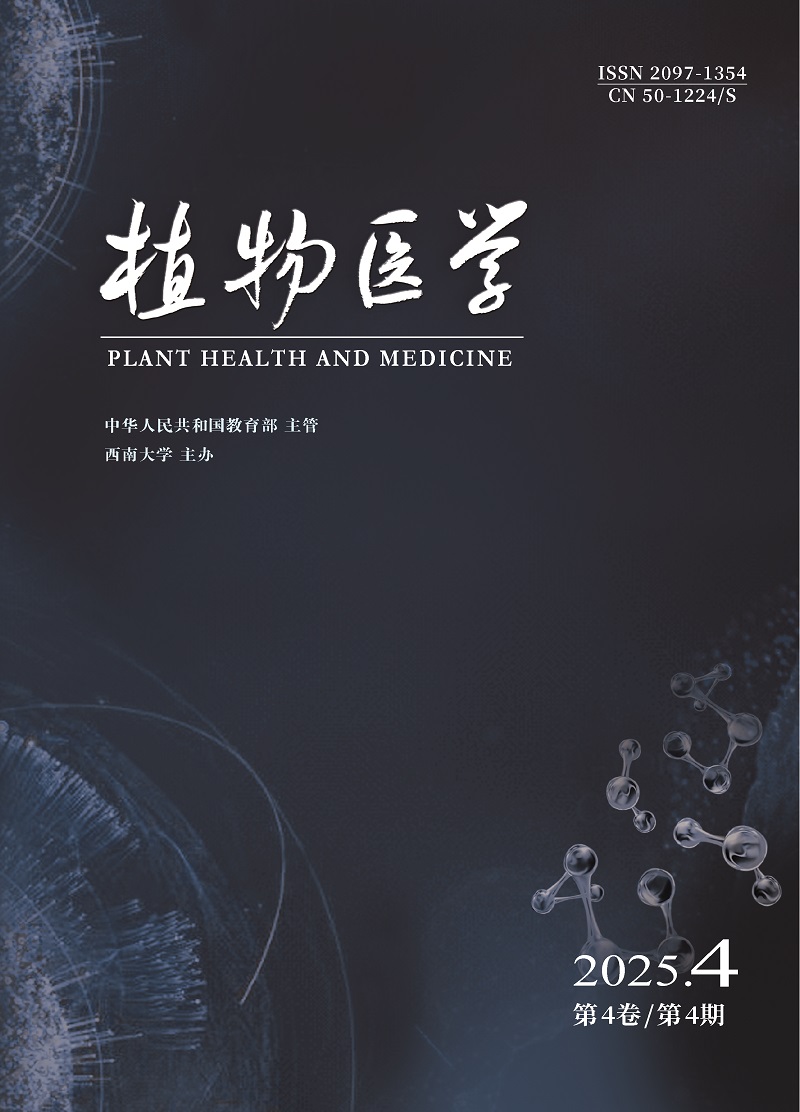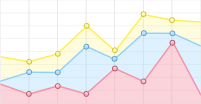-
开放科学(资源服务)标识码(OSID):

-
桃蚜(Myzus persicae)属半翅目,蚜科,又称烟蚜。在设施温室大棚内的茄果类蔬菜上,约10 d繁殖一代,主营孤雌生殖。青海省一般每年9月在设施大棚内定植辣椒,桃蚜自室外十字花科等植物迁入设施内的辣椒,其在设施辣椒上可周年繁殖,不存在越冬滞育现象。桃蚜有翅蚜,对黄色有较强的趋性,对银灰色有忌避习性,且具有较强的迁飞和扩散能力[1]。桃蚜的发生盛期在4-6月,以成蚜和若蚜群集的方式在辣椒幼叶与嫩茎上刺吸汁液,可造成叶片卷缩变形、植株生长不良和萎缩,严重时影响开花和结果,甚至导致植株死亡。桃蚜的分泌物还可引发煤污病,影响作物的光合作用,污染蔬菜光洁度,降低其品质。更为严重的是,桃蚜还会传播多种病毒病,对农业生产有极大危害[2]。翌春6月,设施辣椒拉秧时节会产生有翅蚜,这些有翅蚜迁飞到大田植物上,先进行有性繁殖,随后再以孤雌生殖的方式继续繁育,直至9—10月辣椒定植后,再转入室内继续繁殖危害设施蔬菜[3]。
桃蚜作为世界性的重要害虫之一,对农业的生产和安全造成了严重威胁[4],目前防治桃蚜主要采用吡虫啉、吡蚜酮、啶虫脒、高效氯氰菊酯、溴氰菊酯、联苯菊酯等常规杀虫剂。然而,由于农药滥用等原因,桃蚜对有机磷类、氨基甲酸酯类、部分新烟碱类、拟除虫菊酯类农药逐渐产生了抗药性[5]。因此,研究常用化学杀虫剂和生物杀虫剂对辣椒桃蚜的毒力及田间防治效果,筛选出绿色高效的药剂并进行推广,已成为当前桃蚜防治工作的重点任务。基于此,本文选取了12种杀虫剂单剂及4种混配剂,在设施辣椒大棚内针对主要害虫桃蚜进行了田间药效试验,旨在为农业生产中防控桃蚜提供理论参考依据。
HTML
-
供试作物为设施大棚栽培辣椒(Capsicum annuum),品种为“乐都长辣椒”。供试对象为桃蚜(Myzus persicae)。
-
供试药剂、药剂生产厂家及用量见表 1。
-
试验地位于青海省海东市循化县查汗都斯乡“黄河彩篮”现代菜篮子生产示范基地,属于浅山地区,海拔1 860 m,年平均降水量350~450 mm,为高原干旱半干旱气候区。试验地土壤类型为栗钙土,土壤pH值8.0~8.6,肥力中等,灌水条件良好,前茬作物为番茄。
-
选取除虫菊素、苦参碱、印楝素等12种杀虫剂单剂,以及22%氟啶虫胺腈悬浮剂与70%吡虫啉水分散粒剂、10%烯啶虫胺水剂与60 g/L乙基多杀菌素悬浮剂、10%烯啶虫胺水剂与1.5%除虫菊素水乳剂,25%吡蚜酮可湿粉剂与24%螺虫乙酯悬浮剂4种混配剂,试验设1个空白对照,共17个处理,每个处理重复4次,共68个小区,随机区组排列,每小区面积15 m2。各药剂用量见表 1。
-
试验采用新加坡利农私人有限公司生产的利农牌HD400背负式喷雾器,采取茎叶喷雾法,每667 m2喷施药液量按45 L计,每小区喷液量1 L,每个处理喷液量4 L,对照小区未喷施任何农药和清水。
虫口数量调查方法如下:共开展3次调查,包括药前虫口基数调查及药后第3 d、第7 d辣椒上的活虫口数调查。每小区选择1株辣椒,调查植株的上、左、右、前、后方位,统计由端部向内20 cm长枝条上的桃蚜数量,分别挂牌标记并记录虫口数。
药剂安全性调查方面,在试验过程中,密切观察所喷施的杀虫剂是否对“乐都长辣椒”产生药害及其他异常现象。
-
按如下公式计算虫口存活率和校正防治效果:
虫口存活率(%)=(防治后残虫口数/防治前虫口数)×100%
校正防治效果(%)=[(对照区虫口存活率—处理区虫口存活率)/对照区虫口存活率]×100%
利用SPSS 21.0数据处理软件,通过Duncan’s新复极差法对各处理的校正防治效果进行差异显著性分析。
1.1. 供试作物及害虫
1.2. 供试药剂
1.3. 试验地概况
1.4. 试验设计与方法
1.4.1. 试验设计
1.4.2. 施药方法
1.4.3. 田间防效计算与数据处理
-
从表 2的处理结果可以看出,药后3 d,25%吡蚜酮可湿性粉剂、70%吡虫啉水分散粒剂、22%氟啶虫胺腈悬浮剂与70%吡虫啉水分散粒剂混配、25%吡蚜酮可湿性粉剂与24%螺虫乙酯悬浮剂混配的防效明显高于其他药剂,而相互间无显著差异,防效依次为91.04%、92.77%、93.05%和93.16%。其次为22%氟啶虫胺腈悬浮剂、24%螺虫乙酯悬浮剂、5%啶虫脒乳油、10%烯啶虫胺水剂、25%噻虫嗪水分散粒剂、10%烯啶虫胺水剂与60 g/L乙基多杀菌素悬浮剂混配,防效依次为88.30%、86.55%、85.36%、83.63%、82.34%和85.29%。其中,22%氟啶虫胺腈悬浮剂校正防效显著高于25%噻虫嗪水分散粒剂,其余处理的防效无显著差异。0.3%印楝素乳油、6%鱼藤酮微乳剂、0.3%苦参碱水剂、1.5%除虫菊素水乳剂、5%除虫菊素乳油的防效次之,依次为78.47%、74.81%、74.50%、72.26%和71.46%。10%烯啶虫胺水剂与1.5%除虫菊素水乳剂混配剂的防效最低,显著低于其他药剂,防效仅为67.83%。
药后7 d,25%吡蚜酮可湿性粉剂、70%吡虫啉水分散粒剂、22%氟啶虫胺腈悬浮剂与70%吡虫啉水分散粒剂混配、25%吡蚜酮可湿性粉剂与24%螺虫乙酯悬浮剂混配以及22%氟啶虫胺腈悬浮剂的防效均显著高于其余处理,分别为94.82%、94.47%、95.08%、94.33%和93.67%。24%螺虫乙酯悬浮剂对桃蚜的防效次之,为91.74%。10%烯啶虫胺水剂、25%噻虫嗪水分散粒剂、10%烯啶虫胺水剂与60 g/L乙基多杀菌素悬浮剂的混配剂防效分别为85.97%、85.70%和88.46%。
药后7 d,植物源农药0.3%苦参碱水剂、0.3%印楝素乳油于对桃蚜的防效分别为72.95%、75.08%;植物源农药5%除虫菊素乳油、6%鱼藤酮微乳剂和1.5%除虫菊素水乳剂的防效为66.34%~68.93%;混配剂中防效较佳者为22%氟啶虫胺腈悬浮剂与70%吡虫啉水分散粒剂的混配剂、25%吡蚜酮可湿性粉剂与24%螺虫乙酯悬浮剂的混配剂。
-
在施药前及施药后3 d和7 d对试验田进行田间调查,将各单剂、混配剂处理的辣椒与空白对照的辣椒进行比对,着重观察其生长发育状态,涵盖叶形、叶色、株高、株展、茎粗、果形、果色等指标,未发现处理组与对照组植株出现显著异样。结果表明,在本试验开展期间所喷施的药剂均未对设施辣椒造成药害。
2.1. 不同种类杀虫剂对桃蚜的田间防效分析
2.2. 对设施辣椒的安全性
-
在本试验采用的杀虫剂所含的杀虫活性成分中,印楝素和吡蚜酮具有拒食作用,除虫菊素、烯啶虫胺和氟啶虫胺腈主要作用于昆虫的神经系统;螺虫乙酯、苦参碱、鱼藤酮、吡虫啉、啶虫脒和噻虫嗪,不仅能作用于昆虫的消化系统,还可作用于其神经系统。印楝素主要通过破坏昆虫口器的化学感应器官,使其产生嗅觉忌避从而起到拒食作用。吡蚜酮是一种具有高度选择性的触杀型杀虫剂,内吸活性好,可使蚜虫等半翅目害虫的口针堵塞、停止取食,直至饥饿而亡,从而阻断害虫传毒途径。螺虫乙酯属于内吸性杀虫剂,具有双向内吸传导性能,作用方式以胃毒为主,触杀为辅,发挥作用相对较慢,但持效期可长达8周[6]。
氟啶虫胺腈通过作用于昆虫的烟碱型乙酰胆碱受体内独特的结合位点,能有效防治蚜虫等刺吸式害虫[7]。有研究表明,对桃树蚜虫用药21 d后,螺虫乙酯和氟啶虫胺腈的防效可达到99.9%和82.1%[8]。熊辉等[9]发现,25%吡蚜酮可湿性粉剂不仅表现出优异的速效性,也表现出了较长的持效期,药后7 d防效可达96.90%~99.34%,与本研究结果相近。陶晡等[10]使用25%噻虫嗪水分散粒剂进行防治桃蚜的田间药效试验时发现,药后7 d防效仍可达97%,显著高于本试验结果,很可能是本地区桃蚜已对噻虫啉产生了一定的抗药性。
新烟碱类药剂对蚜虫具有较高的活性。其中,吡虫啉和啶虫脒以其高效且兼具触杀和胃毒作用等特点得到广泛应用,但随着这两种杀虫剂的长期大量使用,我国部分地区的蚜虫已对其产生了不同程度的抗药性[11]。姜伟丽等[12]用5%啶虫脒乳油防治棉蚜,防效可达90%以上,显著高于本实验中同种杀虫剂对桃蚜82.14%的防效,这可能是由于本地桃蚜已对啶虫脒产生了抗药性。
植物源农药具有对环境友好、毒性普遍较低、病虫不易产生抗药性等优点。苦参碱作为一种植物源农药,药后7 d对桃蚜的防效为72.95%,与章杰等[13]在山东防治桃树桃蚜的效果相近。5%除虫菊素乳油、0.3%印楝素乳油、6%鱼藤酮微乳剂这3种植物源农药与化学农药相比,防效相对较低,但使用植物源农药可有效减轻化学农药引发的残留问题[14]。
本试验所选择的7种低毒绿色化学农药对桃蚜的防治效果均在80%以上,而其他5种植物源农药的防效为66%~75%。以单剂1/2剂量混配的药剂,如22%氟啶虫胺腈悬浮剂与70%吡虫啉水分散粒剂、10%烯啶虫胺水剂与60 g/L乙基多杀菌素悬浮剂、25%吡蚜酮可湿性粉剂与24%螺虫乙酯悬浮剂,与单剂的防效差异不明显;而10%烯啶虫胺水剂与1.5%除虫菊素水乳剂混配,防效明显降低,因此,不宜将二者混配使用。通过对上述杀虫剂的防效进行综合分析与比较,推荐在蚜虫发生初期、虫口密度较低时使用植物源杀虫剂,如0.3%苦参碱水剂或0.3%印楝素乳油;在蚜虫大量繁殖期,使用低毒绿色化学杀虫剂,如25%吡蚜酮可湿性粉剂、70%吡虫啉水分散粒剂、22%氟啶虫胺腈悬浮剂、24%螺虫乙酯悬浮剂,或25%吡蚜酮可湿性粉剂与24%螺虫乙酯悬浮剂、22%氟啶虫胺腈悬浮剂与70%吡虫啉水分散粒剂等,因为上述单剂或混配剂在药后7 d的防效仍高于85%。配制药液时,建议采用二次稀释法,以确保药液的均匀性和稳定性,从而对设施辣椒蚜虫进行有效的喷施防治。
本研究通过对设施大棚内辣椒上的桃蚜开展田间药效试验,评价不同作用机理的杀虫剂对桃蚜的防效,旨在为今后农业生产中科学、合理地使用杀虫剂防治蚜虫提供理论参考及指导。





 DownLoad:
DownLoad: